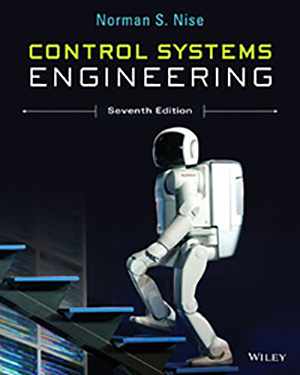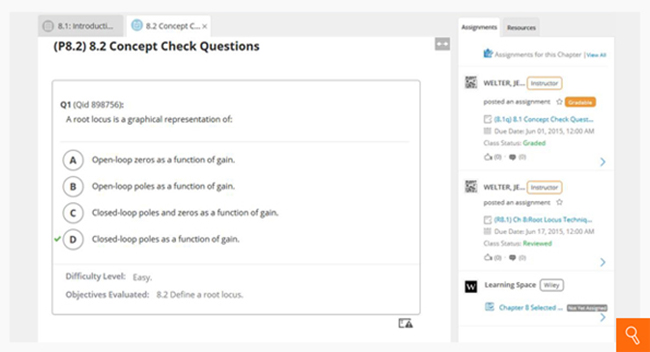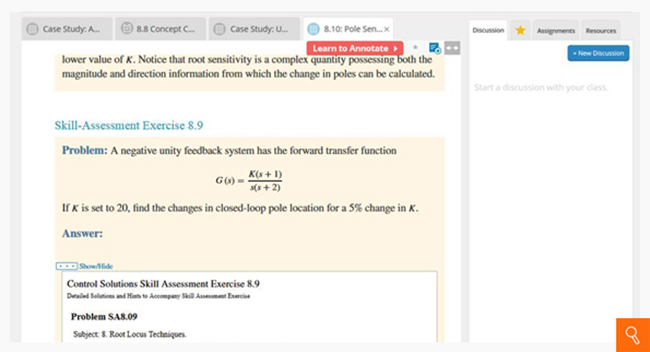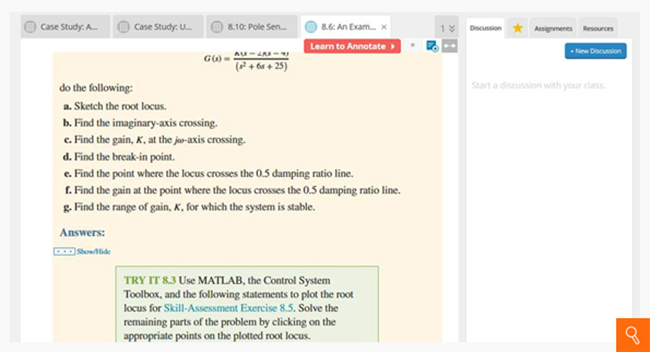
Control Systems Engineering, 7th Edition
By Norman S. Nise
Control Systems Engineering, 7th Edition has become the top selling text for this course. It takes a practical approach, presenting clear and complete explanations. Real world examples demonstrate the analysis and design process, while helpful skill assessment exercises, numerous in-chapter examples, review questions and problems reinforce key concepts. A new progressive problem, a solar energy parabolic trough collector, is featured at the end of each chapter. Ten new simulated control lab experiments now complement the online resources that accompany the text. This edition also includes Hardware Interface Laboratory experiments for use on the MyDAQ platform from National Instruments. A tutorial for MyDAQ is included as Appendix D.
Schedule a Demo Sign Up for a Test Drive Adopt WileyPLUSWant to learn more about WileyPLUS? Click Here

Concept checkpoints help to reinforce learning
Concept Check Questions follow each reading section, helping students to reinforce and build upon the concepts they just learned.

Students develop problem-solving skills through guided exercises
Control Solutions for select Skill Assessment Exercises give students more problem-solving guidance in the form of hints, directions, and detailed solutions.

Students practice building the skills they need to succeed in the course
Try It exercises give students the opportunity to try programming solutions to problems themselves in MATLAB.
- Accessibly written. Nise is noted for his clear writing and accessible presentation. Design Emphasis. Students are encouraged to go beyond a plug-and-chug approach through the use of design problems, progressive analysis and design problems, and examples and problems related to the case studies.
- Real-world case studies. The case studies (an autonomous submersible vehicle and an antenna position control system) are built up gradually throughout the chapters to demonstrate the analysis and design process.
- Strong learning-by-example pedagogical approach. Skill-assessment exercises demonstrate step-by-step techniques to solve most problems; cyber exploration labs show how to apply popular software tools (MATLAB®, LabVIEW®, and Simulink) to control engineering problems.
- Clearly ties mathematics to physical reality. Students can comprehend how theoretical concepts connect to actual system dynamics.
- New Virtual Experiments. The experiments (powered by Quanser) give students the opportunity to manipulate online simulations of real-world controls labs from their own computer.
What’s New
Norman S. Nise teaches in the Electrical and Computer Engineering Department at California State Polytechnic University, Pomona. In addition to being the author of Control Systems Engineering, Professor Nise has contributed to the CRC publications The Engineering Handbook, The Control Handbook, and The Electrical Engineering Handbook.
PREFACE, ix
1. INTRODUCTION, 1
1.1 Introduction, 2
1.2 A History of Control Systems, 4
1.3 System Configurations, 6
1.4 Analysis and Design Objectives, 9
1.5 The Design Process, 14
1.6 Computer-Aided Design, 19
1.7 The Control Systems Engineer, 20
Summary, 21
Review Questions, 22
Problems, 22
Cyber Exploration Laboratory, 29
Bibliography, 30
2. MODELING IN THE FREQUENCY DOMAIN, 33
2.1 Introduction, 34
2.2 Laplace Transform Review, 35
2.3 The Transfer Function, 44
2.4 Electrical Network Transfer Functions, 47
2.5 Translational Mechanical System Transfer Functions, 61
2.6 Rotational Mechanical System Transfer Functions, 69
2.7 Transfer Functions for Systems with Gears, 73
2.8 Electromechanical System Transfer Functions, 77
2.9 Electric Circuit Analogs, 83
2.10 Nonlinearities, 86
2.11 Linearization, 87
Case Studies, 92
Summary, 95
Review Questions, 95
Problems, 96
Cyber Exploration Laboratory, 107
Hardware Interface Laboratory, 110
Bibliography, 112
3. MODELING IN THE TIME DOMAIN, 115
3.1 Introduction, 116
3.2 Some Observations, 116
3.3 The General State-Space Representation, 120
3.4 Applying the State-Space Representation, 122
3.5 Converting a Transfer Function to State Space, 130
3.6 Converting from State Space to a Transfer Function, 136
3.7 Linearization, 138
Case Studies, 141
Summary, 145
Review Questions, 146
Problems, 146
Cyber Exploration Laboratory, 153
Bibliography, 155
4. TIME RESPONSE, 157
4.1 Introduction, 158
4.2 Poles, Zeros, and System Response, 158
4.3 First-Order Systems, 162
4.4 Second-Order Systems: Introduction, 164
4.5 The General Second-Order System, 169
4.6 Underdamped Second-Order Systems, 173
4.7 System Response with Additional Poles, 182
4.8 System Response With Zeros, 186
4.9 Effects of Nonlinearities Upon Time Response, 192
4.10 Laplace Transform Solution of State Equations, 194
4.11 Time Domain Solution of State Equations, 198
Case Studies, 202
Summary, 208
Review Questions, 209
Problems, 210
Cyber Exploration Laboratory, 223
Hardware Interface Laboratory, 227
Bibliography, 232
5. REDUCTION OF MULTIPLE SUBSYSTEMS, 235
5.1 Introduction, 236
5.2 Block Diagrams, 236
5.3 Analysis and Design of Feedback Systems, 245
5.4 Signal-Flow Graphs, 248
5.5 Mason’s Rule, 251
5.6 Signal-Flow Graphs of State Equations, 252
5.7 Alternative Representations in State Space, 256
5.8 Similarity Transformations, 264
Case Studies, 272
Summary, 278
Review Questions, 278
Problems, 279
Cyber Exploration Laboratory, 295
Bibliography, 297
6. STABILITY, 299
6.1 Introduction, 300
6.2 Routh-Hurwitz Criterion, 303
6.3 Routh-Hurwitz Criterion: Special Cases, 305
6.4 Routh-Hurwitz Criterion: Additional Examples, 31
6.5 Stability in State Space, 318
Case Studies, 321
Summary, 323
Review Questions, 323
Problems, 324
Cyber Exploration Laboratory, 332
Bibliography, 333
7. STEADY-STATE ERRORS, 335
7.1 Introduction, 336
7.2 Steady-State Error for Unity Feedback Systems, 339
7.3 Static Error Constants and System Type, 345
7.4 Steady-State Error Specifications, 348
7.5 Steady-State Error for Disturbances, 351
7.6 Steady-State Error for Nonunity Feedback Systems, 353
7.7 Sensitivity, 356
7.8 Steady-State Error for Systems in State Space, 359
Case Studies, 362
Summary, 365
Review Questions, 366
Problems, 367
Cyber Exploration Laboratory, 377
Bibliography, 379
8. ROOT LOCUS TECHNIQUES, 381
8.1 Introduction, 382
8.2 Defining the Root Locus, 386
8.3 Properties of the Root Locus, 388
8.4 Sketching the Root Locus, 390
8.5 Refining the Sketch, 395
8.6 An Example, 404
8.7 Transient Response Design via Gain Adjustment, 407
8.8 Generalized Root Locus, 411
8.9 Root Locus for Positive-Feedback Systems, 413
8.10 Pole Sensitivity, 415
Case Studies, 417
Summary, 422
Review Questions, 423
Problems, 423
Cyber Exploration Laboratory, 439
Hardware Interface Laboratory, 441
Bibliography, 447
9. DESIGN VIA ROOT LOCUS, 449
9.1 Introduction, 450
9.2 Improving Steady-State Error via Cascade Compensation, 453
9.3 Improving Transient Response via Cascade Compensation, 462
9.4 Improving Steady-State Error and Transient Response, 474
9.5 Feedback Compensation, 487
9.6 Physical Realization of Compensation, 495
Case Studies, 500
Summary, 504
Review Questions, 505
Problems, 506
Cyber Exploration Laboratory, 519
Hardware Interface Laboratory, 520
Bibliography, 523
10. FREQUENCY RESPONSE TECHNIQUES, 525
10.1 Introduction, 526
10.2 Asymptotic Approximations: Bode Plots, 531
10.3 Introduction to the Nyquist Criterion, 549
10.4 Sketching the Nyquist Diagram, 554
10.5 Stability via the Nyquist Diagram, 559
10.6 Gain Margin and Phase Margin via the Nyquist Diagram, 563
10.7 Stability, Gain Margin, and Phase Margin via Bode Plots, 565
10.8 Relation Between Closed-Loop Transient and Closed-Loop Frequency Responses, 569
10.9 Relation Between Closed- and Open-Loop Frequency Responses, 572
10.10 Relation Between Closed-Loop Transient and Open-Loop Frequency Responses, 577
10.11 Steady-State Error Characteristics from Frequency Response, 581
10.12 Systems with Time Delay, 585
10.13 Obtaining Transfer Functions Experimentally, 590
Case Study, 594
Summary, 595
Review Questions, 596
Problems, 597
Cyber Exploration Laboratory, 608
Bibliography, 609
11. DESIGN VIA FREQUENCY RESPONSE, 611
11.1 Introduction, 612
11.2 Transient Response via Gain Adjustment, 613
11.3 Lag Compensation, 616
11.4 Lead Compensation, 621
11.5 Lag-Lead Compensation, 627
Case Studies, 636
Summary, 638
Review Questions, 639
Problems, 639
Cyber Exploration Laboratory, 645
Bibliography, 646
12. DESIGN VIA STATE SPACE, 649
12.1 Introduction, 650
12.2 Controller Design, 651
12.3 Controllability, 658
12.4 Alternative Approaches to Controller Design, 661
12.5 Observer Design, 667
12.6 Observability, 674
12.7 Alternative Approaches to Observer Design, 677
12.8 Steady-State Error Design via Integral Control, 684
Case Study, 688
Summary, 693
Review Questions, 694
Problems, 695
Cyber Exploration Laboratory, 703
Bibliography, 704
13. DIGITAL CONTROL SYSTEMS, 707
13.1 Introduction, 707
13.2 Modeling the Digital Computer, 711
13.3 The z-Transform, 714
13.4 Transfer Functions, 719
13.5 Block Diagram Reduction, 723
13.6 Stability, 726
13.7 Steady-State Errors, 733
13.8 Transient Response on the z-Plane, 737
13.9 Gain Design on the z-Plane, 739
13.10 Cascade Compensation via the s-Plane, 742
13.11 Implementing the Digital
Compensator, 746
Case Studies, 749
Summary, 753
Review Questions, 754
Problems, 755
Cyber Exploration Laboratory, 762
Bibliography, 764
APPENDIX A List of Symbols, 767
APPENDIX B MATLAB Tutorial, 771
B.1 Introduction, 771
B.2 MATLAB Examples, 772
B.3 Command Summary, 814
Bibliography, 817
APPENDIX C MATLAB’s Simulink Tutorial, 819
C.1 Introduction, 819
C.2 Using Simulink, 819
C.3 Examples, 824
C.4 Using Simulink for Control System Design, 837
Summary, 846
Bibliography, 847
APPENDIX D LabVIEWTM Tutorial, 849
D.1 Introduction, 849
D.2 Control Systems Analysis, Design, and Simulation, 850
D.3 Using LabVIEW, 851
D.4 Analysis and Design Examples, 853
D.5 Simulation Examples, 865
D.6 Interfacing with External Hardware, 875
Summary, 879
Bibliography, 879
Online location is www.wiley.com/college/nise
GLOSSARY, 881
ANSWERS TO SELECTED PROBLEMS, 889
CREDITS, 895
INDEX
APPENDIX E MATLAB’s GUI Tools Tutorial (Online)
APPENDIX F MATLAB’s Symbolic Math Toolbox Tutorial (Online)
APPENDIX G Matrices, Determinants, and Systems of Equations (Online)
APPENDIX H Control System Computational Aids (Online)
APPENDIX I Derivation of a Schematic for a DC Motor (Online)
APPENDIX J Derivation of the Time Domain Solution of State Equations (Online)
APPENDIX K Solution of State Equations for t0≠0 (Online)
APPENDIX L Derivation of Similarity Transformations (Online)
APPENDIX M Root Locus Rules: Derivations (Online)
Control Systems Engineering Toolbox (Online)
Cyber Exploration Laboratory Experiments Covers Sheets (Online)
Lecture Graphics (Online)
Solutions to Assessment Exercises (Online)

